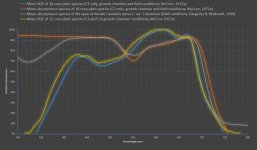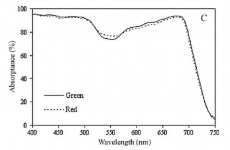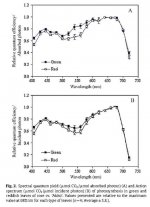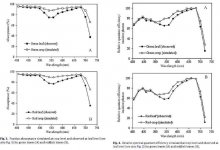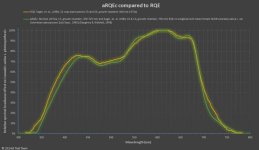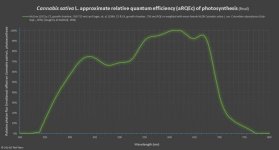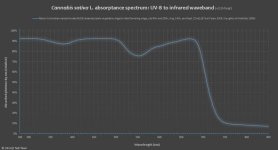Beta Test Team
Member
So because we know our Cannabis absorptance data for 280 to 375 375 nm is not accurate enough I spent some time today researching the issue.
The adaxial (top surface) epidermis layer of a leaf is a major factor in terms of the absorptance of UV range light. In general, the thicker the epidermis the greater the UV-B and UV-A absorptance.
The study I used* looks at this very issue for 6 different higher plant genera. And one studied genus, Kalanchöe, has leaf adaxial epidermis of similar thickness to Cannabis. So we're using that genus as a gauge for UV-B and UV-A absorptance of Cannabis leaves as effected by their adaxial epidermis thickness.
* Ultraviolet Radiation Reflectance, Transmittance, and Absorptance by Plant Leaf Epidermises
https://www.soils.org/publications/aj/abstracts/67/5/AJ0670050720
I looked for a long time and didn't find any data regarding adaxial leaf epidermis thickness for Cannabis (hemp or drug). So I calculated it myself for from the following image. Here is the first we know of Cannabis leaf epidermis thickness data, my edits are in green font:

The above figure shows that the adaxial leaf epidermis for Cannabis is a ballpark thickness of 0.019 to 0.023 mm. However, it's probably best to assume something like 0.020 mm +/- 0.05 mm.
And adaxial leaf epidermis of Kalanchöe studied in this research was 0.016 mm +/- 0.06 mm.
Here is the abaxial (under side) leaf absorptance spectra for Kalanchöe from that study I cited. That genus as studied for that research had absoprtance of 64.9% at 260 nm (UV-C), 65.8% at 280 nm (start of UV-B), 31.3% at 320 nm (start of UV-A), and 7.5% at 360 nm (middle of UV-A).
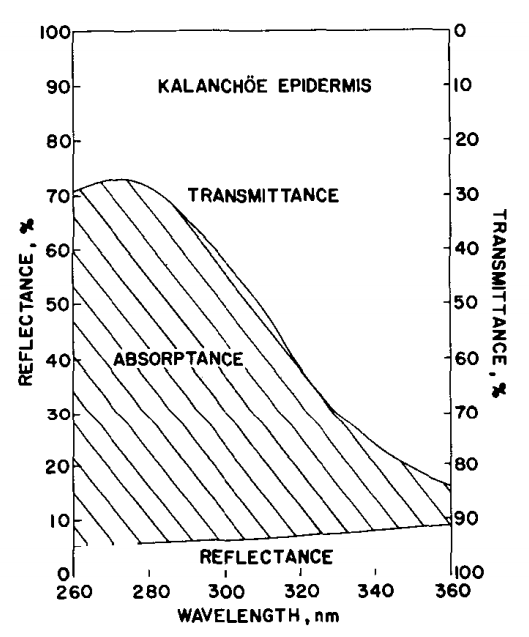
So given the above, we think our UV-B and UV-A absorptance spectra errors are too great. Therefore we're going to try to correct the values. I'll leave the current UV to IR absorptance spectra up I uploaded a few posts ago, and replace it once we update with more accurate figures.
Here's the online source of that image I used of the Cannabis leaf:
http://www.kbg.fpv.ukf.sk/studium_materialy/morfologia_rastlin/webchap10epi/10.5-2.htm
.
The adaxial (top surface) epidermis layer of a leaf is a major factor in terms of the absorptance of UV range light. In general, the thicker the epidermis the greater the UV-B and UV-A absorptance.
The study I used* looks at this very issue for 6 different higher plant genera. And one studied genus, Kalanchöe, has leaf adaxial epidermis of similar thickness to Cannabis. So we're using that genus as a gauge for UV-B and UV-A absorptance of Cannabis leaves as effected by their adaxial epidermis thickness.
* Ultraviolet Radiation Reflectance, Transmittance, and Absorptance by Plant Leaf Epidermises
https://www.soils.org/publications/aj/abstracts/67/5/AJ0670050720
I looked for a long time and didn't find any data regarding adaxial leaf epidermis thickness for Cannabis (hemp or drug). So I calculated it myself for from the following image. Here is the first we know of Cannabis leaf epidermis thickness data, my edits are in green font:
The above figure shows that the adaxial leaf epidermis for Cannabis is a ballpark thickness of 0.019 to 0.023 mm. However, it's probably best to assume something like 0.020 mm +/- 0.05 mm.
And adaxial leaf epidermis of Kalanchöe studied in this research was 0.016 mm +/- 0.06 mm.
Here is the abaxial (under side) leaf absorptance spectra for Kalanchöe from that study I cited. That genus as studied for that research had absoprtance of 64.9% at 260 nm (UV-C), 65.8% at 280 nm (start of UV-B), 31.3% at 320 nm (start of UV-A), and 7.5% at 360 nm (middle of UV-A).
So given the above, we think our UV-B and UV-A absorptance spectra errors are too great. Therefore we're going to try to correct the values. I'll leave the current UV to IR absorptance spectra up I uploaded a few posts ago, and replace it once we update with more accurate figures.
Here's the online source of that image I used of the Cannabis leaf:
http://www.kbg.fpv.ukf.sk/studium_materialy/morfologia_rastlin/webchap10epi/10.5-2.htm
.
Last edited:

